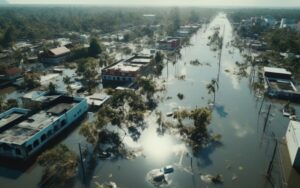To say Erik Weihenmayer is an inspiration would be an understatement. After losing his sight as a teenager, Weihenmayer used his experience — something that would cause many others to give up — to begin a remarkable life free of fear and dedicated to helping others do the same.
Erik Weihenmayer, Jeff Evans, and Eric Alexander on the summit of Mt. EverestWeihenmayer’s outlook, rare and sorely needed in our world, is optimistic, realistic, and unpretentious. He wants the world to live without barriers (hence the names of his philanthropic organizations: No Barriers, No Barriers Youth, and No Barriers Warriors). He travels the world speaking and helping people overcome all kinds of obstacles, whether physical, emotional, or psychological, to live better lives. You may even see him at the 2016 USA Science & Engineering Festival. Although his most famous feat may be climbing Mount Everest – and being the first blind person in the world to do it – it’s certainly not his most courageous. He’s also summited several dangerous peaks, and more recently kayaked the entire Colorado River. Having just returned from summiting Mount Huntington in Alaska, Weihenmayer shared his experiences on this adventure, discussed the role of fear and adrenaline in his other expeditions, and talked tech.
I&T Today: You just returned from Alaska – tell us about it.
EW: A peak like Mount Huntington is in many ways a harder climb than Everest. There is no “walk up”, and it’s in a really isolated location in the Alaska Range. To get there, you fly a single otter plane and land on the glacier. The wheels retract and the skis come out, then you’re off to set up base camp. From there you’re about 4,000 feet from the summit.
I&T Today: Did you run into any obstacles?
EW: When we tried to get to the base, a huge crease opened up. My friend said it was 100 yards wide. After we dealt with that, we climbed for 7 hours in the deep snow to the base of the steep climbing, and it started dumping snow. You don’t want to be on that mountain when it’s snowing. So, we scampered out of there and went down to base camp again. We just hoped the weather would hold out. We have this device called the DeLorme, where you can text and receive weather reports through satellite. We had a two day window, and it looked like it might hold out, so we decided to try one last push. We left at 5 AM, and got to the base around 12. We climbed all the ice pitches and got to the top of them around midnight. We cut a platform with just enough room to sit our butts on this little ice shelf with your feet hanging over the side. We had sleeping bags, but we pretty much shivered the night away until about 6 AM. We brewed up some oatmeal and kept climbing until we summited at about 6:30 PM. Then we rappelled down through the evening. We got down to our base camp at 7:15 in the morning. We squeaked it out!
I&T Today: You mention using the DeLorme. What other tech is important to you daily and on the mountain or river?
EW: The DeLorme is super cool. Back at Mt. Huntington, we had a friend who texted ‘Send it’, which is climber slang, and it was just the motivation we needed. If we hadn’t had that weather report from someone on the outside looking at the Alaska Range and really trying to assess for us, it would have dramatically decreased our ability to make the right decision. And on the Grand Canyon, the biggest game changer was finding the right radio. We literally looked for 2 years, maybe more. When you are in these massive rapids, you can’t hear the person who is guiding you. There may be a 20-foot wall of water that is separating you and him. And if I get flipped by a wave and he shoots by, then he’s suddenly 100 feet down the river. You have to have a radio with a clear voice, and it has to be reliable. After two years, we finally found this little company out of the UK called Neptune Waterproof. They sent us prototypes and all kinds of cool radios that we experimented with. Eventually, they made us some waterproof radios that worked off of Bluetooth. The range is like 50 to 60 feet, which is fine for kayaking. It enabled us to have really clear communication in real time. It was a total game changer.
I&T Today: How is climbing mountains different from kayaking rivers like the Colorado?
EW: The difference between mountains and rivers is that mountains are slow and methodical, step by step, kick by kick, and rivers are completely up to the speed of the river. Rivers move at a frantic pace. I would say climbing is hours of boredom combined with moments of sheer terror. Kayaking is moments of boredom combined with mostly sheer terror. Just knowing that you’re about to embrace something you can’t see, you have to stay loose and fluid very much in the moment. You can’t tense up and get afraid because it doesn’t help you.
I&T Today: Speaking of the f-word, how does fear motivate you?
EW: Fear is something you could write books on. Sometimes fear says, “I’m not ready for something.” So, you listen to that fear. Sometimes fear sabotages you. Even though you’ve created the vision and the motivation for why you are there, and even though you’re committed to this process with your team, the overwhelming uncertainty can create fear. I think it’s a constant conversation or debate between one part of your brain and another.
I&T Today: What has been your most memorable excursion? Is there one that stands out, or are they all special in their own way?
EW: Yeah, there is a sort of weirdness to climbing these mountains. When you look back at those times, you’re suffering and you are embracing the hardship for sure, but for some weird reason, you look back on them with fondness. Part of you is like, Why would I go back to these situations? There is something in those journeys that is just so intense. You seem like you’re on the learning curve, and it’s knife-edged. You’re learning things you never would have learned in any other way. I look back on a lot of my climbs when I was on a huge ice face suffering with a friend, and you getting through it together. It’s something very special.








